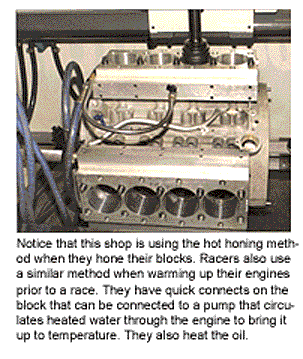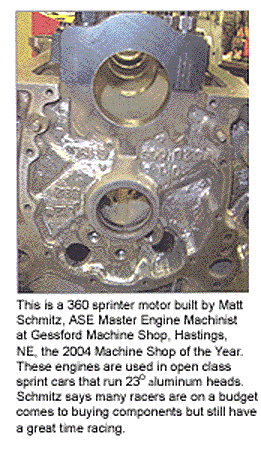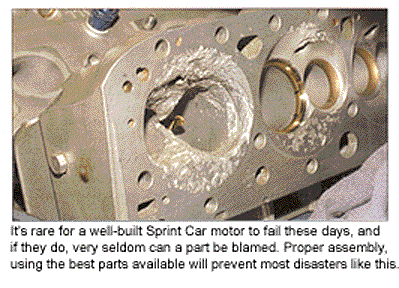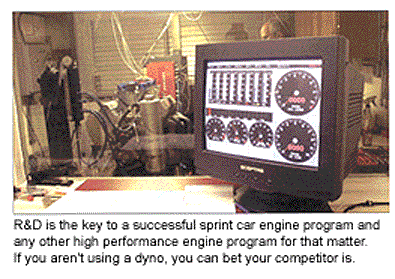While the World of Outlaws, the All Stars, and USAC are the most well known of the sprint car racing organizations in this country, there are nearly fifty organizations that sanction sprint car racing. In addition, that doesn’t take into account the racetracks throughout the country that have their own division of sprint cars.
Although a few of these organizations are what might be called “limited sprints” or “econo sprints” that strictly limit engine modifications, most have much more liberal rules. Some years ago, several organizations attempted to reduce costs for sprint car racing by reducing engine size to 360 cubic inches from the 410 cid limit that most organizations had been using.

For the most part, these attempts failed, as the cost for 360 cid engines nearly reached the same level as the 410’s. Admittedly, this is a rather generalized statement, but keep in mind that each organization has its own rules. Some may allow any modification as long as you stay under the cubic inch limit, while others may specify parts used, such as heads, injectors, or whether you can use an aluminum or cast iron block.
So, that being said, if you want to get into the sprint car engine business, the first thing you need is a rulebook for each organization, or track, that you will be building engines for. Keep in mind that in most cases, sprint car racing is a much higher level of racing than the street stocks, bombers, or even modifieds that you find at many tracks, and, if it is one of the 50+ traveling organizations, they will all be top notch teams. At the top levels of sprint car racing, the drivers are full-time professionals. That is also the case for many who are racing with other organizations throughout the country.
Because their paycheck is directly tied to their finishing position, these drivers and owners are always looking for an edge – and yesterday’s technology just won’t do. Building sprint car engines is much different than it was 10-15 years ago when anyone could build an engine and expect it to perform fairly well. So, if you’ve never built a sprint car engine, expect to have a “learning curve” as you spend a lot of R&D time looking for just the right combination. Sure, you can go out and buy a rotating assembly and build a motor for a sprint car…but remember, so can everyone else. Who has the edge then?
The winners on the track, are those who have something different (read better) than the other competitors. To have racers beating a path to your door, you need to give them an edge; you need to spend time and money on R&D. If you build an engine that consistently beats the competition, not only will most of those competitors become your customers, you will also have as much work as you can handle.
Although not true in every case, for the most part, nearly all sprint car competitors have very good equipment. One reason for this is that the engine rules have stayed pretty consistent for the past 10+ years. That allows a trickle down effect from the full-time “professionals” to the one-night-a-week racer. The top guns in any of the organizations build new each year, while others may compete with the same motor for several years.
The top racers on the Outlaw, All Star, or USAC circuit will have a minimum of six complete motors. One in the race-car, one in the backup car, one or two at the engine shop being freshened up and two spares sitting in the trailer. Most racers will not do any work to the motors other than maintenance like oil changes, valve adjustments or maybe changing valve springs.
The motors have become changeable parts, just like tires or shocks. If teams have a problem with a motor, even a minor one, they usually won’t try to fix it. They just replace it and send it back to the builder. For the top teams an engine will go back to the builder to be rebuilt after 15 races.
On the World of Outlaws circuit it’s not unusual to run more than 100 races a year. With six motors, that averages out to just over 16 races each. Each engine will be rebuilt at least once during the season. Most rebuilds will include new pistons, bearings, rings, valve springs and gaskets. The rods and crankshaft are magnufluxed and also replaced if needed. The heads will get a complete going over, and the fuel pump will be flow tested.
At the end of the season, the top racers will typically sell most of the parts, including the chassis and motors. They’ll start with all new equipment when the next season starts. This cycle has been a boon for the local racers. They can have top-line equipment, albeit a year old, at a very low price. For many Saturday night racers, that equipment could last them several seasons, and, if they have a good engine builder, their builder will be able to keep that engine up to date in most cases.
Okay, so you’ve never built a sprint car motor and you want to know, “Where do I start?” The first place to start is with a rulebook. And that’s what it is: a start, but you also need to head to the racetrack. Find out what the racers need, or what’s working for them.

Lets look at how the top builders approach engine building, keeping in mind that they all had to start somewhere too, just like you. Legendary shops reached the top because they built a product that produced results, just like any other successful business. The top builders all have at least one dyno cell; many have more than one. The dyno is used mainly for R&D, but most top builders also run every engine they build on the dyno before it leaves the shop.
The nice thing about a dyno is that if you dyno each engine, and if you build and maintain a file of the dyno charts, you can compare engine to engine (if you’re just building one or two types). Some NASCAR teams with an engine program have what they call the “one percent rule,” in which every engine must dyno to within one percent of the standard for that engine. On an 800 hp engine, that would be just 8 hp.
You won’t need to be quite that perfect, but you will get a feel for where the engines should be on a dyno. If you dyno an engine after building and it’s outside your standards, you’ll know you have a problem and you sure wouldn’t want that engine going to a customer when it’s less than your best.
The same holds true when you “freshen” or rebuild an engine for a customer. When you dyno the rebuild you can refer to the dyno chart for that engine and compare your rebuild numbers to the numbers for that engine when it was new, or when it was rebuilt the last time. This also provides you with a measure of quality control on your product. Putting out a bad product will “kill” your high performance business.
Most of the top builders now also have a “Spintron” for endurance testing purposes. Used mainly for valve train components, a Spintron can assure you of the durability of not only the parts you use, but also, the combinations you try in your R&D work. Some builders also have a chassis dyno, which is another way to test combinations during R&D.

The top builders have also developed relationships with suppliers. Although parts like rods and crankshafts are generally used “off-the-shelf” other parts such as pistons, cams and heads are usually custom manufactured to the builders’ specifications. These custom designs are the result of a lot of R&D time. And all of this R&D that has been going on has made for huge gains in horsepower. Fifteen years ago the top 410 sprint cars were probably averaging 650-700 hp; today that figure is 800 plus!
In addition to huge horsepower improvements, continual R&D has produced little “secrets” that keep leaders ahead of the pack. Just look at the dominance of the restrictor plate motors built by Dale Earnhardt Inc. on the NASCAR NEXTEL Cup Series. Don’t expect them to share those secrets with you!
As an automotive machine shop or rebuilder, you may have most of the equipment needed to do performance work; you may even have a dyno. Perhaps you’ve even built high performance engines, but want to step it up a little more. Regardless of whether you’re just getting into performance engines, or want to increase involvement, you need to do two things; one, get out to the track to find out what is working now and what the racers need, and two, start talking to your suppliers; they will be your best source of information getting into this market.
Purebred “race engines” such as those used in sprint car racing, are total packages. Each and every part is just one piece of a puzzle that must fit together perfectly for the best performance. Many of the NASCAR NEXTEL Cup teams have their own engine departments, some of which have upwards of 100 people building engines, performing a lot of R&D, etc. R&D is the lifeblood of these top teams. Sprint car teams haven’t reached that point yet! They are still relying on shops like yours to keep them on top.
Another thing to keep in mind is a chassis dyno. Though it was mentioned earlier, you may be wondering why an engine shop would need one. The fact is, at least for sprint cars, the engine is an integral part of the chassis setup. A good, strong engine will help the chassis perform as it was intended.

Of course the block is the foundation of a great engine. For a pure race engine, forget starting out with a junkyard block. For one thing, good blocks are getting hard to find, and for another thing, by the time you get a junkyard block conditioned for high performance, you’ll probably find that it would have been cheaper to start with an aftermarket block.
There are many manufacturers out there that produce a good aftermarket block whether cast iron or aluminum. Depending on the organization, you may or may not be allowed to run an aluminum block. Most of the 410 cid groups do allow aluminum blocks and they are preferred by all the top teams. Although more costly initially, the aluminum blocks are also less costly in the long run for the average weekend racer because of the greater strength and repairability.
Another reason to use an aftermarket block is because they are made for racing. In most cases they will have a raised camshaft bore and wider pan rails for greater rod clearance. An aftermarket block is also much more likely to have the bores in the right place and to be squared up to the centerline of the crankshaft. You can also expect that the cylinder walls will be consistent in their thickness. Of course, if it’s an aluminum block, it will probably require some machining. How’s that saying go? “If its aluminum, it ain’t straight.”
Another point about clearances. In the past engine builders would grind on the blocks and also grind a little bit off the rods to gain needed clearance. Although generally not a problem on the blocks, grinding on the rods has always been an iffy proposition. Grinding can cause stress risers and can lead to a rod failure. Most aftermarket blocks along with the rods are manufactured so that you have the clearance needed without getting the grinder out.
The next choice to be made would be the heads and choosing them may take quite a bit of research. The heads you choose can make or break the engine. The best research tool is to go out to the track and find out what is working, what the racers are using, and their opinion on different brands.
Your piston and cam manufacturer would be a great source of information on head choice, their parts must work with the heads and most will have the information you need to make a choice. Most of the top manufacturers are designing their products to work with other manufacturers products. Open most of the leading piston catalogs and you’ll find pistons designed specifically for the top sprint car heads. You’ll find the same thing with the cam manufacturers; cams designed for particular combinations.
Gone are the days when you could just buy an “off-the-shelf” piston or cam to fit any combination. If you are buying an off-the-shelf piston design, the piston manufacturer will match it to the heads you will be using. Your target compression ratio will also be a factor in piston choice. Sprint car engines will normally run compression ratios in the 15:1 – 16.5:1 ranges.
The same goes for the cam, although the cam manufacturer will want to know a lot of other things as well. The expected rpm range the engine will see, whether racing on dirt or asphalt, winged or non-winged, compression ratio, heads, etc. The heads and cam will give you the most performance gains; design the rest of the package around those.
Of course, the valve train is very important and you will want to get it as light as possible. Most of the top teams are using titanium valves, but your customer may not have the budget for that. Regardless of whether you use titanium or steel valves, you should use titanium retainers, as that will save you some weight. A sprint car will generally see an rpm range of 6,000-8,500, quite a load for the valve train.
For rocker arms, the “shaft style” rockers that several manufacturers produce have really helped valve train stability. You will also want to use the best springs available, as they are generally the weakest link in the valve train. Pushrod length is probably the most important piece of the valvetrain puzzle. Too long or too short of a pushrod will cause improper valve train geometry. Follow the cam manufacturer’s guidelines on proper valve train geometry. In the case of shaft rockers, the manufacturer will supply instruction and guidance. Take your time in getting the geometry right.
Another part that at one time was a weak link is the connecting rods. You should use the best rods available and be careful of “counterfeits.” While it might be nice to consider titanium rods, they aren’t legal with most organizations and the cost can be somewhat prohibitive. Although rods are blamed for many engine failures, if the engine is built using high quality parts and those parts are properly installed, rod failures should be few and far between.
With new metallurgy and engineering, if installed properly, rods just don’t fail of their own accord anymore. However, if you are still using a torque wrench to tighten rod bolts, you need to go back to school. The proper way to tighten rod bolts is with a “rod bolt stretch gauge.” Again, you need to follow the manufacturer recommended tightening procedure.
While we’re on the subject of rods, consider this. Unless you have the experience that tells you otherwise, you should shoot for a rod ratio of around 1.5:1 to 1.6:1. That will give good compromise of stroke and rod length. A 3.800? stroke combined with a 6.00? rod will give you a 1.57:1 rod ratio. A longer rod is also preferable to a shorter rod because it will put less friction on the cylinder walls. A longer rod will give the piston increased dwell at the top of the cylinder, resulting in increased power.
Combine the 3.800? stroke with a 4.125? bore and your engine will have a displacement of just over 406 cubic inches. Add a .015? head gasket with 52 cc chamber size heads and we end up with a 15.8:1 compression ratio, just about what we were shooting for. Decreasing the chamber size to 47 cc will increase our compression ratio to about 17:1. Of course we have several choices to get our preferred displacement and compression ratio.
When deciding on a target bore and stroke, keep in mind the customer you’re building for. If this will be your customer’s only motor and he has a limited budget, you’ll need to leave room for cleaning up the bores during rebuilds. Our example above would allow for two .010? cleanups out to a bore of 4.145? and still be legal in the 410 cid division. After that it will be time to replace the sleeves or the block.
Block preparation and headwork have been covered in previous issues of Engine Builder so we won’t discuss them here. The thing to remember is that sprint car engines are at the forefront of performance engine design. If you’re willing to spend the time and money to become an expert in this market and to find some of your own little “secrets” you’ll have racers beating a path to your door.













